Treasures of the NAPO Expo: Paper (and Plastic) Solutions for Organizing Paper
Last week, I shared some of the wonders of the vendor expo at the annual conference of the National Association of Professional Organizers. You may wonder how exciting an organizing expo might be. Well, imagine yourself in a candy store, a cozy bookshop, a George Clooney emporium…picture being surrounded by the newest and niftiest of whatever floats your boat.
Now imagine Paper Doll and her organizing cohorts and you can imagine the excitement that abounded in the NAPO Expo, with about a thousand attendees (organizers and exhibitors), in an open-air, fully-attended, air conditioning-challenged annex. From Thursday’s boxed luncheon to the closing bell after the awards ceremony, the Expo was a frenzy of sampling, research and shopping.
This week, we’ll review some of the paper (and plastic) non-digital organizing tools that caught my eye:
by Oprah’s buddy and previous Paper Doll mentionee Peter Walsh (in cahoots with Office Max) was the freebie that generated the most excitement. Many of us had seen a preview webcast designed for industry members, and we were all eager to see the elements of the system up close. The Starter Kit contained the following:
Document Wallet (1) —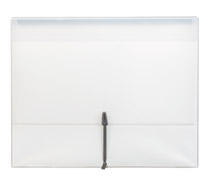 A sturdy, inch-thick rectangular, boxy but flexible project envelope with an elasticized closure, is perfect for containing file folders, document sleeves, loose papers and more. An interior sheet of plastic hugs the back panel with just enough space for one piece of paper, allowing you to insert a customized cover page or labeling system. The wallet is just translucent enough for some bold typeface to be read, or you could insert different colored sheets in different wallets to color code each for your needs: financial, legal, medical, household, personal, etc.
A sturdy, inch-thick rectangular, boxy but flexible project envelope with an elasticized closure, is perfect for containing file folders, document sleeves, loose papers and more. An interior sheet of plastic hugs the back panel with just enough space for one piece of paper, allowing you to insert a customized cover page or labeling system. The wallet is just translucent enough for some bold typeface to be read, or you could insert different colored sheets in different wallets to color code each for your needs: financial, legal, medical, household, personal, etc.
Document Sleeves (3) — Unlike file folders, these are more like sheet protectors, bound on two sides, and open on two sides (think: a capital “L”), allowing papers to easily slide in. Although most of the [In] Place items are translucent, the sleeves are slightly more opaque, blocking content from prying eyes. The back of each document sleeve is slightly larger than the front, making it easy to use the enclosed, oddly-shaped Post-Its for color-coded labeling.
Document Envelope (1) — Although the Starter Kit includes only one example of this less-opaque, patterned, snap-closure envelope, if you were to buy a packet of document envelopes, you’d receive three different assorted patterns. Mine has a cute little diamond pattern on the front and reverse of the envelope, while the envelope flap is pattern-free. Although more translucent than the document sleeves, the envelopes also provide good coverage for your sensitive materials.
File Folders (3) — These were the least appealing items to Paper Doll, as instead of left, center and middle tabs, as one sees with standard file folders, the top tab (i.e., the top “back” of the folder extends almost the full 11 horizontal inches, and there are faint white markings to indicate where the special narrowed-top Post-Its can be affixed for color-coded labeling. The file folders also have white horizontal markings on the reverse side (five abreast above three larger ones abreast), to allow for labeling directly on the poly folders with the enclosed erasable marker.
Super-Sticky Post-It Note Block (1) — The one in my kit is white, though myriad colors are available. The narrowed top of the notes (as if someone were trying to make them look more like little houses) allows them to appear similarly-shaped to standard file label tabs.
The one in my kit is white, though myriad colors are available. The narrowed top of the notes (as if someone were trying to make them look more like little houses) allows them to appear similarly-shaped to standard file label tabs.
Binder Clip Tabs (5) — 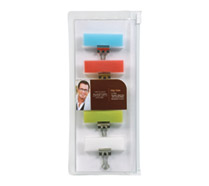 Picture teeny tiny alligator clips. Now, change the black part to sliver and affix sturdy color coded plastic tabs, similar to the kind usually used to label hanging folders. The nifty part is that there are rubberized coverings over the tiny clip handles, allowing them to better clip the paper. The clips are designed to group and bind similarly themed file folders.
Picture teeny tiny alligator clips. Now, change the black part to sliver and affix sturdy color coded plastic tabs, similar to the kind usually used to label hanging folders. The nifty part is that there are rubberized coverings over the tiny clip handles, allowing them to better clip the paper. The clips are designed to group and bind similarly themed file folders.
In addition to these items in the Starter Kit, the system also includes binder clips (like the binder clip tabs, but used when you don’t need the labeling function), poly wallets to hold the little house-shaped Super-Sticky Post-It Notes, expanding files, file totes, interlocking hanging folders, magazine files, desktop sorters and a rolling case file to take the whole system on the road.
A few keys about the [In] Place System:
- The obvious advantage of the [In] Place system is durability. Paper files and folders bend, crease, tear and generally can’t stand up to tough treatment. These poly files, sleeves, wallets, folders, etc. should stand the test of time.
- Practically all of the elements of the system are made of a translucent, slippery polypropylene plastic. This is an advantage for people who like to vaguely see the contents of their file and project folders without opening them, yet desire privacy from prying eyes. Unless the contents were printed in bold type in a large, clear font, it’s unlikely that anyone looking over a shoulder could make out enclosed text.
- Another possible advantage, which many organizers originally perceived as a disadvantage, is that the system is largely color-free. There are color Post-It labels and binder clips, but the white/clear poly materials provide a neutral platform upon which a user can create customized color themes for organizing and accenting.
- For people who love a pre-built system, prefer poly to paper and either live near an Office Max or will order online from OfficeMax.com, [In] Place could appeal.
- For those who are unsure of the recycle-ability of polyproplylene, prefer colorful folders to color-coded labels, who want more variety (or bargain options) than Office Max might offer, it’s still worth checking out the video and web site to see what creative ideas the system can stir.
BUT WAIT, THERE’S MORE! Actually, lots more to report, of items that require far less explanation.
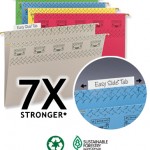
Filed under “great minds think alike”, both Smead’s Tuff Hanging™ Folders and
Esselte’s Pendaflex HangTuff™ Hanging Folders offer a huge leap forward in the world of hanging folders!
Smead’s Tuff Hanging Folders purport to be seven times stronger than the competition (one assumes that’s a comparison with standard hanging folders) and are 40% stronger in order to resist some of the major hanging folder problems–bending and bowing (of the rods) and tearing of the folders. The rods have been specially-designed and reinforced; the rod tips are coated for extra smoothness and strength. If you’d like to try your hand at testing Tuff Hanging™ folders, click to get a free sample. They run out quickly, but check back often.
An associated highlight came with the display of Easy-Slide Tabs. Instead of those icky plastic hanging file tabs that never fit where they ought, Smead has created a new type of tab that slides into place (on standard or “Tuff” hanging files). You simply slip the tab onto the folder and secure it in place by aligning the tab notches with the pre-cut folder slots. Better yet, the tab can be easily repositioned by just flexing (it’s easy-peasy: just squeezy!) and sliding it to the new location.
Unfortunately, Pendaflex’s HangTuff™, won’t be available for sale (or photo ops) until this summer. However, our NAPO Expo samples state they use SureHook™ technology and tension-spring rods to keep the rods from bending, enabling the folders stay on the hanging rails. Happily, hanging files from Esselte/Pendaflex and Smead can be used interchangeably, so you can expect a Paper Doll Hanging Folder Death Match sometime before Labor Day!
Back to Smead, regular readers know how much Paper Doll loves tickler files, so you can imagine how pleased I was with a number of their newer binder-style products:
Smead Tax Organizer 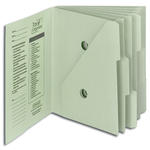 has six secure pockets (for convenient and safe transport), as well as easy instructions and tax checklists printed on the internal cover.
has six secure pockets (for convenient and safe transport), as well as easy instructions and tax checklists printed on the internal cover.
Smead Weekly Organizer 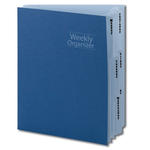 is a less intensive version of my beloved tickler file. Instead of slots for 31 days and 12 individual months, this weekly version has pre-printed dividers to create a slot for each day of the week. Separate your task-assigning papers, calendars, and projects easily for when your life needs to planned one week at a time…and when you can’t even imagine thinking about next week, let alone next month.
is a less intensive version of my beloved tickler file. Instead of slots for 31 days and 12 individual months, this weekly version has pre-printed dividers to create a slot for each day of the week. Separate your task-assigning papers, calendars, and projects easily for when your life needs to planned one week at a time…and when you can’t even imagine thinking about next week, let alone next month.
Smead Project Organizer 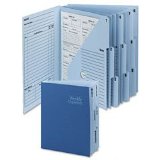 is not officially “new”, but deserves a lot of love in the age of project management software. Too often, all of the project paperwork tends to be forgotten in the glitter of Basecamp and MS Project. Each binder has a stiff, durable cover, ten secure pockets with tough two-ply numbered tabs, and spacious areas for listing task follow-ups (date assigned, tasks, assignees, start and end dates) and notes.
is not officially “new”, but deserves a lot of love in the age of project management software. Too often, all of the project paperwork tends to be forgotten in the glitter of Basecamp and MS Project. Each binder has a stiff, durable cover, ten secure pockets with tough two-ply numbered tabs, and spacious areas for listing task follow-ups (date assigned, tasks, assignees, start and end dates) and notes.
While I’m a big fan of all of the above Smead organizers/binders, which are made of 10% recycled content and 10% post-consumer material, I’m less enthusiastic about the Smead Travel Organizers, 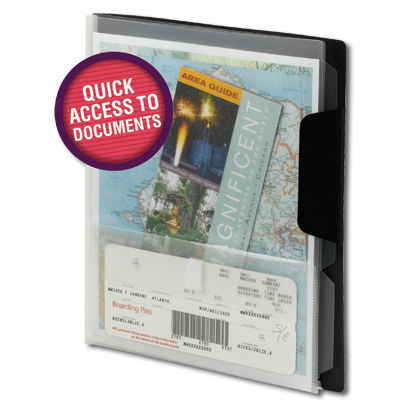 which are more like durable sheet protectors than binders. Made of a clear, acid-free archival polypropylene that seems to lack the quality or the durability of the [In] Place products, the Travel Organizer has three clear plastic tabbed sheets, a stiffer plastic backing and a small #10 envelope-sized, Velcro-closured envelope attached to the front divider. The pocket is designed to hold boarding passes and receipts, while itineraries, notes, flat maps and confirmation numbers would be easily slotted in the tabbed pages.
which are more like durable sheet protectors than binders. Made of a clear, acid-free archival polypropylene that seems to lack the quality or the durability of the [In] Place products, the Travel Organizer has three clear plastic tabbed sheets, a stiffer plastic backing and a small #10 envelope-sized, Velcro-closured envelope attached to the front divider. The pocket is designed to hold boarding passes and receipts, while itineraries, notes, flat maps and confirmation numbers would be easily slotted in the tabbed pages.
While the above products for organizing paper were my favorites of the new items, you might also want to check out:
- Family Facts, makers of binder-style planners including the Family Life Organizer & Planner, GO planners for busy parents, Pregnancy Planner, Wall Calendar, Peace of Mind Planner for health and estate planning and School Year Memento Keeper.
- Freedom Filer, a NAPO Expo perennial, is a self-purging file system that comes in ready-made systems or customizable kits.
- Priceless Legacy is an intriguing option for preserving a loved one’s legacy by collecting photos and memorabilia and conducting interviews with Legacy Consultants to create “This Is Your Life”-style histories in hardcopy book form. It’s less an organizing tool than a way to collect information in a unified display format. (We’ll discuss Priceless Legacy in the future, when we talk about creating customized books.)
- Recipe Relish’s Recipe Nest has a newish design for collecting of your recipes as full-page documents. It’s a combination box, clipboard and easel made of spill-proof vinyl in designer colors and patterns, with special themes for particular types of cooking.
If you’ve already used any of these products and would like to share your opinion, please leave a comment.
Next week: a rundown of NAPO Expo’s electronic/digital offerings for organizing your photos and documents, keeping track of your tasks and appointments, accessing helpful lists and more.
 The
The 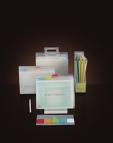




Follow Me